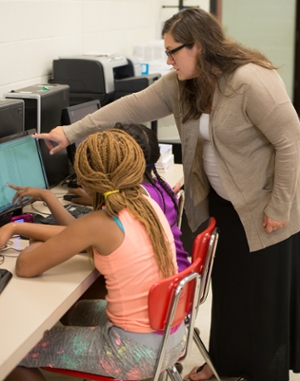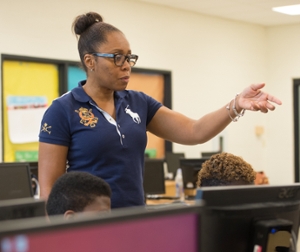 East St. Louis middle school students are looking at their city through a camera lens, capturing images that help provide a deeper understanding of the culture and history embedded in their local streets. Their photographs will be one portion of a website that includes content-rich digital maps the students are creating through Southern Illinois University Edwardsville’s “Digital East St. Louis” project.
East St. Louis middle school students are looking at their city through a camera lens, capturing images that help provide a deeper understanding of the culture and history embedded in their local streets. Their photographs will be one portion of a website that includes content-rich digital maps the students are creating through Southern Illinois University Edwardsville’s “Digital East St. Louis” project.
The three-year project, which began this summer, is using digital humanities, a field that uses digital technologies to study questions related to history and culture, to generate interest in computing and information technologies among minority middle school-aged students. It is supported by an $846,000 Innovative Technology Experiences for Students and Teachers (ITEST) grant awarded to SIUE from the National Science Foundation (NSF).
The multidisciplinary effort is being led by Sharon Locke, director of the SIUE Center for STEM Research, Education and Outreach; Jessica DeSpain, English professor and co-director of the Interdisciplinary Research and Informatics Scholarship (IRIS) Center at SIUE; and Liza Cummings, professor of curriculum and instruction at SIUE.
“Research shows that middle school is when children begin to lose interest in STEM fields,” said Locke, principal investigator. “This study is examining out-of-school learning and what role it can have in shaping students’ STEM interest, attitudes and educational choices.
“The average American spends less than five percent of their life in a classroom,” she continued. “We need to understand what types of programs best complement classroom learning and promote lifelong learning in STEM. Our research will examine changes in student interests as well as their gains in technology skills over time.”
Students will gain knowledge and experience relative to careers in a variety of fields including IT, web development, information science, graphic design and mass communication.
During the project’s tenure, participants will produce a comprehensive website of artifacts that will be an ongoing resource for the community. They will use GIS (geographic information systems) technology and database design and management to create content for the site, including a walking tour of East St. Louis neighborhoods. Students will also interview community members, photograph historical sites, write stories about the region and film important cultural events.
 “Our research goal is to gauge whether the use of humanities-based and place-based learning will increase student interest in technologically advanced fields,” DeSpain said. “We also hope to encourage students to take ownership and develop pride in their community and motivate them to pursue a college education in a STEM field.”
“Our research goal is to gauge whether the use of humanities-based and place-based learning will increase student interest in technologically advanced fields,” DeSpain said. “We also hope to encourage students to take ownership and develop pride in their community and motivate them to pursue a college education in a STEM field.”
“The students will feature their project at Coding for Community Showcases,” Locke added. “We also will have a parent advisory group that will help us connect to individuals in the community who can contribute their time and expertise.”
Area middle school teachers and an after-school/summer program coordinator are teaching the curriculum. Their participation allows for the spreading of the humanities-based approach to STEM learning in other academic environments. The program model will be made widely available to educators nationwide.
“This project is an outstanding example of what can be accomplished when people from different disciplines come together to tackle a problem,” Locke said. “We have faculty and staff with expertise in STEM, digital humanities, history, African American studies, curriculum and instruction, K-12 teaching and informal learning.
The three-year program will run all week for four weeks through the summer, as well as 15 Saturdays during the school year. Through the NSF grant, up to 50 students can participate. Students receive breakfast, a snack and lunch, along with free transportation to a local middle school.
Interested sixth through ninth graders can apply for the “Digital East St. Louis” project by contacting Dr. Liza Cummings at lcummin@siue.edu.
Photo: Rachel Pehle works with two participants to upload photos for the walking tour of East St. Louis.
Amanda Garner-Brooks instructs “Digital East St. Louis” students.